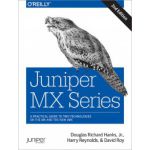Juniper MX Series: A Comprehensive Guide to Trio Technologies on the MX

Preț: 291,00 lei
Disponibilitate: la comandă (vezi secțiunea "Despre livrare")
ISBN: 9781491932728
Editura: O'Reilly
Anul publicării: 2016
Pagini: 1140
DESCRIERE
Discover why routers in the Juniper MX Series—with their advanced feature sets and record-breaking scale—are so popular among enterprises and network service providers. This revised and expanded edition shows you step-by-step how to implement high-density, high-speed Layer 2 and Layer 3 Ethernet services, using Router Engine DDoS Protection, Multi-chassis LAG, Inline NAT, IPFLOW, and many other Juniper MX features.
This second edition was written by a Senior NOC engineer, whose vast experience with the MX Series is well documented. Each chapter covers a specific Juniper MX vertical and includes review questions to help you test what you’ve learned. This edition includes new chapters on load balancing and vMX—Juniper MX’s virtual instance.
- Work with Juniper MX’s bridging, VLAN mapping, and support for thousands of virtual switches
- Examine Juniper MX high-availability features and protocols
- Use Trio Chipset’s load balancing features for different types of traffic
- Explore the benefits and typical use cases of vMX
- Add an extra layer of security with Junos DDoS protection
- Create a firewall filter framework that applies filters specific to your network
- Discover the advantages of hierarchical scheduling
- Combine Juniper MX routers, using a virtual chassis or Multi-chassis LAG
- Install network services such as Network Address Translation (NAT)
-
Chapter 1Juniper MX Architecture
-
Junos OS
-
Juniper MX Chassis
-
Trio
-
Line Cards and Modules
-
Switch and Control Board
-
Summary
-
Chapter Review Questions
-
Chapter Review Answers
-
-
Chapter 2Bridging, VLAN Mapping, IRB, and Virtual Switches
-
Isn’t the MX a Router?
-
Layer 2 Networking
-
Junos Interfaces
-
Interface Bridge Configuration
-
Service Provider Interface Bridge Configuration
-
Enterprise Interface Bridge Configuration
-
Service Provider VLAN Mapping
-
Bridge Domains
-
Integrated Routing and Bridging
-
Virtual Switch
-
VXLAN
-
Summary
-
Chapter Review Questions
-
Chapter Review Answers
-
-
Chapter 3Stateless Filters, Hierarchical Policing, and Tri-Color Marking
-
Firewall Filter and Policer Overview
-
Filter Operation
-
Policing
-
Applying Filters and Policers
-
Advanced Filtering Features
-
Bridge Filtering Case Study
-
Service Provider DDOS Filtering Case Study
-
Summary
-
Chapter Review Questions
-
Chapter Review Answers
-
-
Chapter 4Routing Engine Protection and DDoS Prevention
-
RE Protection Case Study
-
DDoS Protection Case Study
-
DDoS Case Study
-
Suspicious Control Flow Detection
-
Mitigate DDoS Attacks
-
BGP Flow-Specification Case Study
-
Summary
-
Chapter Review Questions
-
Chapter Review Answers
-
-
Chapter 5Trio Class of Service
-
MX CoS Capabilities
-
Trio CoS Flow
-
Hierarchical CoS
-
Per-VLAN Queuing for Non-Queuing MPCs
-
Trio Scheduling and Queuing
-
MX Trio CoS Defaults
-
Flexible Packet Rewrite
-
Predicting Queue Throughput
-
CoS Lab
-
Add H-CoS for Subscriber Access
-
Chapter Review Questions
-
Chapter Review Answers
-
-
Chapter 6MX Virtual Chassis
-
What Is Virtual Chassis?
-
MX-VC Configuration
-
VCP Interface Class of Service
-
Summary
-
Chapter Review Questions
-
Chapter Review Answers
-
-
Chapter 7Trio Load Balancing
-
Junos Load Balancing Overview
-
Trio Load Balancing and Backward Compatibility
-
Advanced Load Balancing
-
Summary
-
Chapter Review Questions
-
Chapter Review Answers
-
-
Chapter 8Trio Inline Services
-
What Are Trio Inline Services?
-
J-Flow
-
Network Address Translation
-
Tunnel Services
-
Port Mirroring
-
Layer 2 Analyzer
-
Summary
-
Chapter Review Questions
-
Chapter Review Answers
-
-
Chapter 9Multi-Chassis Link Aggregation
-
Multi-Chassis Link Aggregation
-
Inter-Chassis Control Protocol
-
MC-LAG Modes
-
Case Study
-
Summary
-
Chapter Review Questions
-
Chapter Review Answers
-
-
Chapter 10Junos High Availability on MX Routers
-
Junos High-Availability Feature Overview
-
Graceful Routing Engine Switchover
-
Graceful Restart
-
Nonstop Routing and Bridging
-
In-Service Software Upgrades
-
ISSU Lab
-
Summary
-
Chapter Review Questions
-
Chapter Review Answers
-
-
Chapter 11The Virtual MX
-
Why Use vMX and for What Purpose?
-
A Technical Overview of vMX
-
vMX and the Virtual World
-
Resources for Installing vMX for Lab Simulation
-
Technical Details of the vMX
-
Summary
-
Chapter Review Questions
-
Chapter Review Answers
-
Accesul clienţilor
-Top 10
-Cărţi noi
-- 344,25 leiPRP: 382,50 lei
- 1505,52 leiPRP: 1672,80 lei
- 546,21 leiPRP: 606,90 lei
Promoţii
-- 280,00 leiPRP: 350,00 lei
- 29,25 leiPRP: 45,00 lei
- 29,25 leiPRP: 45,00 lei








RECENZII